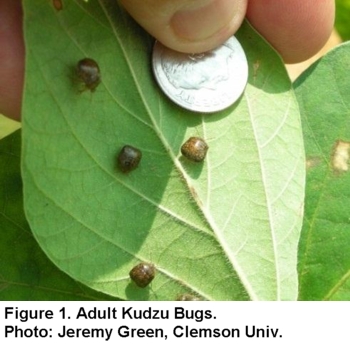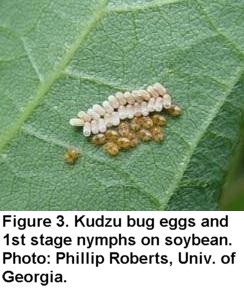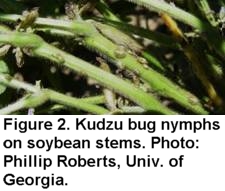Kudzu Bug
ENTFACT-154: Kudzu Bug | Download PDF
by Doug Johnson, Extension Entomologist
University of Kentucky College of Agriculture, Food, and Environment

A new, invasive, sap-feeding pest of soybean from Asia is expected to transform insect management in the Southeast and including Kentucky. The kudzu bug was first discovered on kudzu in the vicinity of Atlanta, Georgia, during the fall of 2009. It has quickly become established as a severe economic pest of soybean in Georgia, North Carolina, South Carolina, and Alabama. In 2013 the spread continued to include all of the states east of the Mississippi and south of the Ohio River.
In August of 2013 Kudzu bugs were collected in Bell, Laurel, and Whitley counties, all along the Interstate 75 corridor. It is unknown whether these insects represent populations that arrived in 2013 or resulted from overwintering after previous introduction. Nevertheless, reproduction was occurring as both juvenile and adult life stages were collected. Kudzu and soybean were also sampled in Kentucky near the Kentucky-Tennessee border along the I-65 and I-24 corridors in August and October of 2013. No Kudzu bugs were collected from these samples.
Impact on Soybean
The kudzu bug uses its piercing sucking mouth parts to feed on sap from the phloem. Injury results from nutrient and moisture loss, rather than a direct loss of biomass from removal of plant tissue as with chewing insects or direct damage to beans and pods as with stinkbugs. Furthermore, sooty mold can develop on the leaves from the sugary excretion of the insect, reducing photosynthetic output. Adults (Fig. 1) and nymphs (Fig. 2) feed on stems (last instar nymphs with purplish wing pads), while small nymphs have been observed feeding on leaf veins. In 2011, yield losses of up to 47 percent were recorded in Georgia on untreated beans on a research station near Midville; only two kudzu bugs were found at this location the previous fall.
Life Cycle
Initial research indicates that the kudzu bug overwinters as an adult near, but not in kudzu patches and in soybean fields in plant debris and behind tree bark, but it will also attempt to overwinter in structures such as houses and other buildings, where it can be a nuisance.

When temperatures warm, the strong-flying, adults move from overwintering sites into kudzu, early planted soybeans and possibly, wisteria. Overwintered adults that move from overwintering sites directly to soybeans prefer those that are early-planted and/or early maturing. These adults then lay egg masses (Fig. 3), and the resulting nymphs develop through five stages producing the 1st generation kudzu bug adults in about six to eight weeks. These first generation adults will produce offspring in a second generation that will result in 2nd generation adults that may move into soybeans that have been planted later. These second generation adults will eventually move off their summer hosts (including soybean) and into overwintering sites to become the overwintered generation for the following year.
Management
Migration of kudzu bug from kudzu to soybean takes place over several weeks, so application of an insecticide is not recommended until nymphs are observed on soybean, even though densities of the migrating adults can be quite large. The migration in Kentucky is as yet unknown. However it begins in March and April, in North Carolina. The second yearly migration of the first generation is expected to begin in July and continue until mid-August. Field edges are colonized first, and generally contain the largest populations though the bugs will move to the interior of the field. Kudzu bug is most effectively sampled with a sweep net. Several randomly selected samples of 15 sweeps (defined, firm pendulum "swooshes" of the net) per sample should be taken from interior areas of the field. A preliminary threshold of on average, one nymph-stage bug per sweep (i.e., 15 nymphs per 15-sweep sample) is recommended and may help reduce the need for multiple sprays.
Insecticide evaluations conducted in Georgia and South Carolina indicate that bifenthrin (e.g. Brigade), bifenthrin + imidacloprid combinations (e.g. Brigadier) and lambda-cyhalothrin + thiamethoxam (e.g. Endigo) are very active against kudzu bug on soybean. These products also have supplemental labels for the kudzu bug. A number of other insecticides provided control in the 80 to 90 percent range in a summary of nineteen tests conducted in Georgia and South Carolina in 2010 and 2011. Because these chemistries are broad-spectrum, beneficial insects will likely be eliminated, putting fields at greater risk for mid- to late-season caterpillar infestations, such as green cloverworm, corn earworm, and armyworm species. Fields should be intensively scouted through R7 for these and all other pests. Initial studies are underway in several states to the south of Kentucky to determine the impact of manipulating planting dates (later plantings appear to have fewer kudzu bugs), and the effect of maturity groups and variety on attractiveness and susceptibility to kudzu bug.
It is currently unclear if kudzu bug will be an economically important pest in Kentucky in the 2014 season. However, soybean producers across Kentucky’s production region, especially in the I-75, I-65, I-24, and I-69 corridors are encouraged to keep a close watch on their 2014 soybean crop. The Grain Crops Update Blog (http://graincrops.blogspot.com/), Kentucky Pest News (http://www2.ca.uky.edu/agcollege/plantpathology/extension/kpn/current.html), and Twitter by following: @DrDougStinkBugs will be the primary methods of delivering updated information.
Reference
-
Reisig, D. and J. Bacheler. 2012. Kudzu bug (Megacopta cribraria), a new potentially devastating pest of soybeans. NC State Univ.
Issued: 3/14
CAUTION! Pesticide recommendations in this publication are registered for use in Kentucky, USA ONLY! The use of some products may not be legal in your state or country. Please check with your local county agent or regulatory official before using any pesticide mentioned in this publication.
Of course, ALWAYS READ AND FOLLOW LABEL DIRECTIONS FOR SAFE USE OF ANY PESTICIDE!
Images: University of Kentucky Entomology, unless otherwise credited

